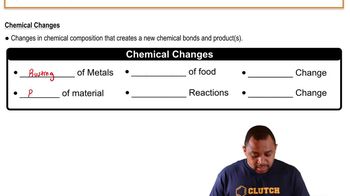Consider the reaction: A(g) ⇌ B(g) + C(g) Find the equilibrium concentrations of A, B, and C for each value of Kc. Assume that the initial concentration of A in each case is 1.0 M and that the reaction mixture initially contains no products. Make any appropriate simplifying assumptions. b. Kc = 0.010
Ch.15 - Chemical Equilibrium
Chapter 15, Problem 63
Consider this reaction at equilibrium: CO(g) + Cl2(g) ⇌ COCl2(g) Predict whether the reaction will shift left, shift right, or remain unchanged after each disturbance. a. COCl2 is added to the reaction mixture. b. Cl2 is added to the reaction mixture. c. COCl2 is removed from the reaction mixture.
 Verified step by step guidance
Verified step by step guidance1
Identify the principle that governs the shift in equilibrium: Le Chatelier's Principle, which states that if a dynamic equilibrium is disturbed by changing the conditions, the position of equilibrium shifts to counteract the change.
For part (a), when COCl2 is added, the system will try to reduce the concentration of COCl2 by shifting the equilibrium to the left, favoring the formation of CO and Cl2.
For part (b), when Cl2 is added, the system will try to reduce the concentration of Cl2 by shifting the equilibrium to the right, favoring the formation of COCl2.
For part (c), when COCl2 is removed, the system will try to increase the concentration of COCl2 by shifting the equilibrium to the right, favoring the formation of COCl2 from CO and Cl2.
Summarize the shifts: (a) shift left, (b) shift right, (c) shift right.
Key Concepts
Here are the essential concepts you must grasp in order to answer the question correctly.
Le Chatelier's Principle
Le Chatelier's Principle states that if a dynamic equilibrium is disturbed by changing the conditions, the system will adjust to counteract the change and restore a new equilibrium. This principle helps predict the direction of the shift in a reaction when a change in concentration, pressure, or temperature occurs.
Recommended video:
Guided course

Le Chatelier's Principle
Equilibrium Constant (K)
The equilibrium constant (K) quantifies the ratio of the concentrations of products to reactants at equilibrium for a given reaction at a specific temperature. Changes in concentration of reactants or products can affect the position of equilibrium, but the value of K remains constant unless the temperature changes.
Recommended video:
Guided course

Equilibrium Constant K
Concentration Changes
Changes in the concentration of reactants or products can shift the position of equilibrium. Adding a reactant or product will shift the equilibrium towards the side that consumes the added substance, while removing a substance will shift it towards the side that produces more of that substance, thereby helping to re-establish equilibrium.
Recommended video:
Guided course

Chemical Changes
Related Practice
Textbook Question
1
views
Textbook Question
Consider this reaction at equilibrium: 2 BrNO(g) ⇌ 2 NO(g) + Br2(g) Predict whether the reaction will shift left, shift right, or remain unchanged after each disturbance. a. NO is added to the reaction mixture.
Textbook Question
Consider this reaction at equilibrium: 2 BrNO(g) ⇌ 2 NO(g) + Br2(g) Predict whether the reaction will shift left, shift right, or remain unchanged after each disturbance. b. BrNO is added to the reaction mixture.
Textbook Question
Consider this reaction at equilibrium: 2 BrNO(g) ⇌ 2 NO(g) + Br2(g) Predict whether the reaction will shift left, shift right, or remain unchanged after each disturbance. c. Br2 is removed from the reaction mixture.
